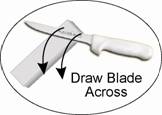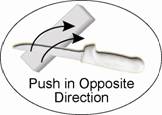Knife Sharpening Guide
Using a Sharpening Stone
Most manufacturers ship their cutting tools without keen edges to avoid damage in transit. The blades will need a good sharpening to realize their full potential. Use the largest stone affordable for a straight edge as it allows use of full surface for wider tools.


-
Place the heel of the blade flat on the stone in a perpendicular or slightly angled position.
-
Tilt the back of the blade up to the desired angle (15 to 30 degrees depending on the application: 15º for fillets, 23º for kitchen or pocket knives, and 30º for cleavers)
-
Holding wrists rigid draw the blade against the surface diagonally the length of the stone – like you were trying to take a thin slice of the stone – beginning at the heel of the knife and ending at the top.
-
Flip the blade over and repeat from the opposite end. Continue this action until a wire edge appears.
-
Then move to the next finer stone and repeat until sufficiently sharp. Note: It is very important that the angle presented to the stone at the beginning of the process be maintained throughout the sequence.
Using a Butcher’s Steel

-
Grasp the sharpening steel firmly with your left hand (in right handed), placing the thumb securely behind the guard.
-
Place the heel of the blade against the steel at a 90° angle (see figure A).
-
While keeping the cutting edge against the steel, raise the back of the blade approximately 1⁄4" off the steel – or at 20° (see figure B).
-
Try to maintain this angle and apply constant, moderate pressure as you draw the blade smoothly across and down the full length of the steel in one continuous motion until the blade tip completes the stroke by passing off the steel near the guard (see figure C).
-
Repeat for the other side of the blade, only this time under the steel (see figure D).